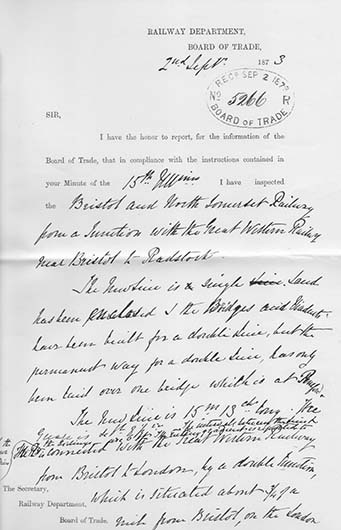Report of Colonel H Rich (Board of Trade Railway Inspector)
into the proposed opening of the Bristol and North Somerset Railway
2nd September 1873
Original Document - The National Archive, Kew. MT6 117/17

Railway Department
Board of Trade
2nd September 1873
Sir,
I have the honour to report, for the information of the Board of Trade, that in compliance with the instructions contained in your minute of the 15th Ultimo, I have inspected the Bristol and North Somerset Railway from a junction with the Great Western Railway near Bristol to Radstock.
The new line is single, land has been purchased and the bridges and viaducts have been built for a double line but the permanent way for a double line has only been laid over one bridge which is at Pensford.
The new line is 15 miles 18 chains long. The gauge is 4ft 8 ½in. The intervals between the line and the sidings are 6ft; the ruling gradient is reported to be 1 in 58 and the sharpest curve to have a radius of 13 chains.
The railway is connected with the Great Western Railway from Bristol to London by a double junction, which is situated about ¾ of a mile from Bristol on the London side. The stations are Brislington, Pensford, Hallatrow, Clutton, Welton and Radstock – all of these except the last are on gradients of 1 in 71 to 1 in 200, but as they are placed in the hollows at the bottom of inclines and that it would be difficult to alter them, I recommend that they be permitted to remain as they are. The line was commenced a long time since.
The permanent way consists of a Vignoles pattern rail, that weighs 72lbs per linear yard. It is fished and fixed with fang bolts and dog spikes to sleepers laid transversely, at an average distance of 3ft apart. The sleepers are 9ft long 10in by 5in. The line is well ballasted.
There are turntables at Radstock and at Birmingham (Sic) which are the terminal stations.
The works consist of twenty over bridges nineteen are built of stone with brick arches and one has wrought iron girders. Twenty-six under bridges – Fourteen consist of stone and brick, eight have cast iron girders and four have wrought iron girders. There are two viaducts – one over the river Avon has stone piers and wrought iron girders and one at Pensford consists of sixteen semicircular brick arches on stone piers – Fourteen arches have spans ranging from 51ft to 57ft 10in and two have spans of twenty-eight feet. The widest space is [??] feet.
There are vertical deviations beyond the parliamentary limits at:
- 3m 50ch – 3m 65ch
- 4m 24ch – 4m 63ch
- 5m 65ch
- 7m 70ch – 8m 75ch
- 9m 50ch – 10m 76ch
- 13m 50ch
The gradients are in most cases somewhat worse in consequence of these deviations, but I was informed that the landowners have made no objections to these alterations.
There is a level crossing of a public road at Radstock. The gates close across the road and railway. They are worked from the adjacent signal cabin and are interlocked with the signals.
All the signals and points on the railway are worked from signal cabins and interlocked. The arrangements for working the line on the block telegraph system were very nearly completed.
The following required to be done
- Several bridges shewed slight settlements. The cracks should be pointed and they should be carefully watched for some time.
- One of the three sets of facing points should be taken out at Pensford station.
- The rails on the Avon viaduct and Pensford under bridge require fastening with through bolts.
- The bolt lock on the loop line at the junction with the Great Western Railway was badly fixed by Messrs Saxby and Farmer and did not work effectively.
- The gates at Radstock required bolts.
- One line of rails in the level crossing required to be taken up and the crossing should be paved (Marginal Note: I required this as shunting is forbidden and the 2nd line afforded the means of shunting)
- Clocks were required in some of the signal cabins and the shelves for the telegraph instruments interfered with the view of the signalmen and with the working of the boxes and required to be fixed at the sides of the cabins.
- Diagrams of the lines of rails and signals are required in the signal cabins – the locking of the signals and points at Radstock, which were arranged for working up and down lines at that station required to be changed for working the station as a single line until such time as the railway is opened to Frome and Radstock and the station is used as a passing place.
The Engineer (Mr Clarke) undertook to have all these services completed at once and I submit that the Board of Trade may sanction the opening of the Bristol and North Somerset Railway as soon as a satisfactory undertaking as to the proposed mode of working is sent in.
The Great Western Station at Bristol is in the process of reconstruction.
This very necessary work appears to progress very slowly indeed.
I have etc.
H Rich (Colonel RE)
To return to the History Page - Simply close this window